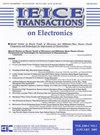Estimation of Core Size Distribution of Magnetic Nanoparticles using High-<i>T</i><sub>c</sub> SQUID Magnetometer and Particle Swarm Optimizer-based Inversion Technique
IF 0.6
4区 工程技术
Q4 ENGINEERING, ELECTRICAL & ELECTRONIC
引用次数: 0
Abstract
In this work, the core size estimation technique of magnetic nanoparticles (MNPs) using the static magnetization curve obtained from a high-Tc SQUID magnetometer and a metaheuristic inversion technique based on the Particle Swarm Optimizer (PSO) algorithm is presented. The high-Tc SQUID magnetometer is constructed from a high-Tc SQUID sensor coupled by a flux transformer to sense the modulated magnetization signal from a sample. The magnetization signal is modulated by the lateral vibration of the sample on top of a planar differential detection coil of the flux transformer. A pair of primary and excitation coils are utilized to apply an excitation field parallel to the sensitive axis of the detection coil. Using the high-Tc SQUID magnetometer, the magnetization curve of a commercial MNP sample (Resovist) was measured in a logarithmic scale of the excitation field. The PSO inverse technique is then applied to the magnetization curve to construct the magnetic moment distribution. A multimodal normalized log-normal distribution was used in the minimization of the objective function of the PSO inversion technique, and a modification of the PSO search region is proposed to improve the exploration and exploitation of the PSO particles. As a result, a good agreement on the Resovist magnetic core size was obtained between the proposed technique and the non-negative least square (NNLS) inversion technique. The estimated core sizes of 8.0484 nm and 20.3018 nm agreed well with the values reported in the literature using the commercial low-Tc SQUID magnetometer with the SVD and NNLS inversion techniques. Compared to the NNLS inversion technique, the PSO inversion technique had merits in exploring an optimal core size distribution freely without being regularized by a parameter and facilitating an easy peak position determination owing to the smoothness of the constructed distribution. The combination of the high-Tc SQUID magnetometer and the PSO-based reconstruction technique offers a powerful approach for characterizing the MNP core size distribution, and further improvements can be expected from the recent state-of-the-art optimization algorithm to optimize further the computation time and the best objective function value.利用High-<i>T</i><sub>c</sub>基于SQUID磁强计和粒子群优化器的反演技术
本文提出了一种基于高tc SQUID磁力计静态磁化曲线的磁性纳米颗粒(MNPs)核心尺寸估计技术和基于粒子群优化(PSO)算法的元启发式反演技术。高tc SQUID磁强计由高tc SQUID传感器与磁通互感器耦合构成,用于检测样品的调制磁化信号。磁化信号通过磁通互感器平面差动检测线圈顶部试样的横向振动来调制。利用一对初级线圈和励磁线圈来施加平行于检测线圈敏感轴的励磁场。利用高tc SQUID磁力计,测量了商用MNP样品(Resovist)在对数尺度上的磁化曲线。然后将粒子群反演技术应用于磁化曲线,构造磁矩分布。采用多模态归一化对数正态分布对粒子群反演技术的目标函数进行最小化,并对粒子群搜索区域进行了改进,以提高粒子群粒子的探测和开发效率。结果表明,该方法与非负最小二乘(NNLS)反演技术在Resovist磁芯尺寸上有较好的一致性。估计的磁芯尺寸为8.0484 nm和20.3018 nm,与文献中使用商用低tc SQUID磁力计与SVD和NNLS反演技术报道的值吻合良好。与NNLS反演技术相比,PSO反演技术具有无需参数正则化即可自由探索最优岩心尺寸分布的优点,并且由于构造分布的平稳性,易于确定峰值位置。高tc SQUID磁强计与pso重构技术的结合为表征MNP磁芯尺寸分布提供了强有力的方法,并且可以期待最新的优化算法进一步改进,以进一步优化计算时间和最佳目标函数值。
本文章由计算机程序翻译,如有差异,请以英文原文为准。
求助全文
约1分钟内获得全文
求助全文
来源期刊

IEICE Transactions on Electronics
工程技术-工程:电子与电气
CiteScore
1.00
自引率
20.00%
发文量
79
审稿时长
3-6 weeks
期刊介绍:
Currently, the IEICE has ten sections nationwide. Each section operates under the leadership of a section chief, four section secretaries and about 20 section councilors. Sections host lecture meetings, seminars and industrial tours, and carry out other activities.
Topics:
Integrated Circuits, Semiconductor Materials and Devices, Quantum Electronics, Opto-Electronics, Superconductive Electronics, Electronic Displays, Microwave and Millimeter Wave Technologies, Vacuum and Beam Technologies, Recording and Memory Technologies, Electromagnetic Theory.
 求助内容:
求助内容: 应助结果提醒方式:
应助结果提醒方式:


